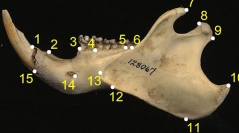

 European Journal of Taxonomy
934 (93) - Pages 93-186
European Journal of Taxonomy
934 (93) - Pages 93-186In this second part of the study, using a ‘clean’ dataset without very low precision landmarks and outliers, I describe how to compare mandibular size and shape using Procrustes methods in adult North American marmots. After demonstrating that sex differences are negligible, females and males are pooled together with specimens of unknown sex and species are compared using a battery of tests, that estimate both statistical significance and effect size. The importance of allometric variation and its potential effect on shape differences is also explored. Finally, to provide potential clues on founder effects, I compare the magnitude of variance in mandibular size and shape between the Vancouver Island marmot (VAN) and the hoary marmot, its sister species on the mainland. In almost all main analyses, I explore the sensitivity of results to heterogeneous sample size and small samples using subsamples and randomized selection experiments. For both size and shape, I find a degree of overlap among species variation but, with very few exceptions, mean interspecific differences are well supported in all analyses. Shape, in particular, is an accurate predictor of taxonomic affiliation. Allometry in adults, however, explains a modest amount of within-species shape change. Yet, there is a degree of divergence in allometric trajectories that seems consistent with subgeneric separation. VAN is the most distinctive species for mandibular shape and mandibular morphology suggests a long history of reduced variation in this insular population. Geometric morphometrics (GMM) is a powerful tool to aid taxonomic research. Regardless of the effectiveness of this family of methods and the apparent robustness of results obtained with GMM, however, large samples and careful measurements remain essential for accuracy. Even with excellent data, morphometrics is important, but its findings must be corroborated with an integrative approach that combines multiple lines of evidence to taxonomic assessment. The analytical protocol I suggest is described in detail, with a summary checklist, in the Appendix, not to miss important steps. All the analyses can be replicated using the entire dataset, which is freely available online. Beginners may follow all the steps, whereas more experienced researchers can focus on one specific aspect and read only the relevant chapter. There are limitations, but the protocol is flexible and easy to improve or implement using a programming language such as R.